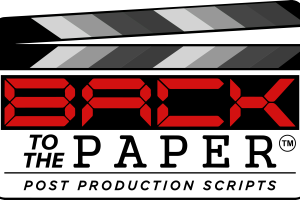Are you trying to get a handle on runaway postproduction costs? Well, here’s the good news. We know a simple and obvious cost saving solution you may have overlooked. Our tip is to lower your expenses by ordering your
closed captioning service together with your combined continuity and spotting list (CCSL).
How will that save you money?
This article will explain why bundling your orders makes economic sense. And we’ll even give you an idea of how much you may save. Plus, we’ll look at the additional benefits of ordering the two services together.
How Much Money Could You Save?
Let’s look at the cost of closed captioning. Back to the Paper charges a standard $6 per minute. So, a 90-minute video would cost you $450.
But if you ordered closed captioning when you
order your CCSL for the same project, you would pay only $180 for the closed captioning. That’s right. You’d save $270. You would pay what amounts to only $2 per minute.
Let’s put that in perspective. Your savings of $270 would be enough to order a separate standalone closed captioning service at the regular price for a different 45-minute video.
Why is Closed Captioning Less Expensive When Bundled With CCSL?
Before we began offering postproduction scripts, such as a CCSL with film time codes or an as-broadcast script, we specialized in closed captioning. Over time, we developed a level of expertise using advanced software with a well-trained and highly skilled staff.
When it became time to expand into postproduction scripts, we realized that we could leverage our years of closed captioning experience to create a top-of-the-line CCSL. All we had to do was begin the process by making a nearly complete captioning file.
So, when we completed the CCSL, the closed captioning only needed tweaking to get it to the industry broadcast level. The process saved us time and money.
So, there was no way we were going to charge our customers the full price. Why shouldn’t they also benefit from what we were doing?
Additional Benefits of Combining Closed Captioning with CCSL
There are at least two additional benefits to combining closed captioning and CCSL. There’s a notable increase in speed when you bundle the services. And the accuracy of both documents increases.
Speed
If you were to order the services separately, there’s a duplication of effort. You’d have to fill out the same forms and answer the same questions. Plus, you’d have to make payment arrangements twice.
The situation is worse if you order the two services from two separate companies. In addition to the steps just mentioned, you’d also have to supply both companies with copies of the video. You’d also have to deal with separate company representatives and their assistants.
Accuracy
When the closed captioning and CCSL services are performed together, they should be in complete agreement. That’s why we recommend ordering the services from the same firm.
What could be more irritating than to learn that one company transcribed the dialogue differently than the other? Then when you check the source material, you learn that both transcription services were wrong. You can eliminate that problem by letting one firm, such as Back to the Paper, handle both assignments.
How Closely Related Are Closed Captioning and CCSL?
To understand the similarities and differences between closed captioning and CCSL, it’s necessary to remind ourselves of what they are and the purposes they serve.
Closed Captioning
Closed captioning was originally seen as a help to
those with hearing loss. They could follow a television broadcast by reading helpful onscreen text.
However, besides the deaf and hard of hearing, it’s also used by those who are not yet comfortable understanding the spoken word in a new language.
You may have noticed that bars and restaurants often make use of subtitling services. Captions allow establishments to show a can’t-miss sporting event or news program without disturbing other customers who prefer a quiet atmosphere.
To serve its audience, closed captioning must be accurate. And it must appear on the screen at the right time. If it shows on the screen a bit too soon or a fraction too late, all the suspense or humor the scriptwriter and director put into the scene can be lost.
In addition to dialogue, closed captioning can present other helpful information. For example, it can indicate which off-camera character is speaking. Closed captioning can also note if music is playing or if there are sound effects.
CCSL
A CCSL is also a type of transcript, but it includes much more than closed captioning. It’s the marriage of two documents.
One captures the action while the other catalogs the audio. A CCSL will place the action entries on the left side of the page and the
dialogue list on the right.
A CCSL is a comprehensive document that notates every cut of every scene in the video. Be aware that just one hour of a modern action movie can contain far more than 1000 cuts. The remake of “King Kong” clocked in at
187 minutes with 3,099 shots.
For each shot, the CCSL describes the angle from which the crew photographed the cut. It also includes mention of the characters, action, and scenery in the shot. And a CCSL also goes into more detail than closed captioning when describing the music and sound effects.
The CCSL is called a postproduction script because its use doesn’t come into play until the video is made. It’s not used on set. But its record of what the video contains comes in handy to help establish legal copyright ownership.
Where to Find Closed Captioning at a Reasonable Price
Can you see the financial wisdom in ordering closed captioning in conjunction with a CCSL? We hope so. We don’t want you to waste your money.
That’s why we invite you to
contact Back to the Paper today. You’ve worked hard on your project. Now it’s our turn to put our closed captioning and CCSL experience to work for you.

